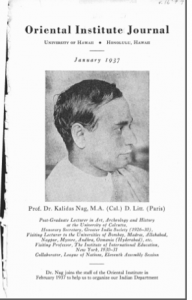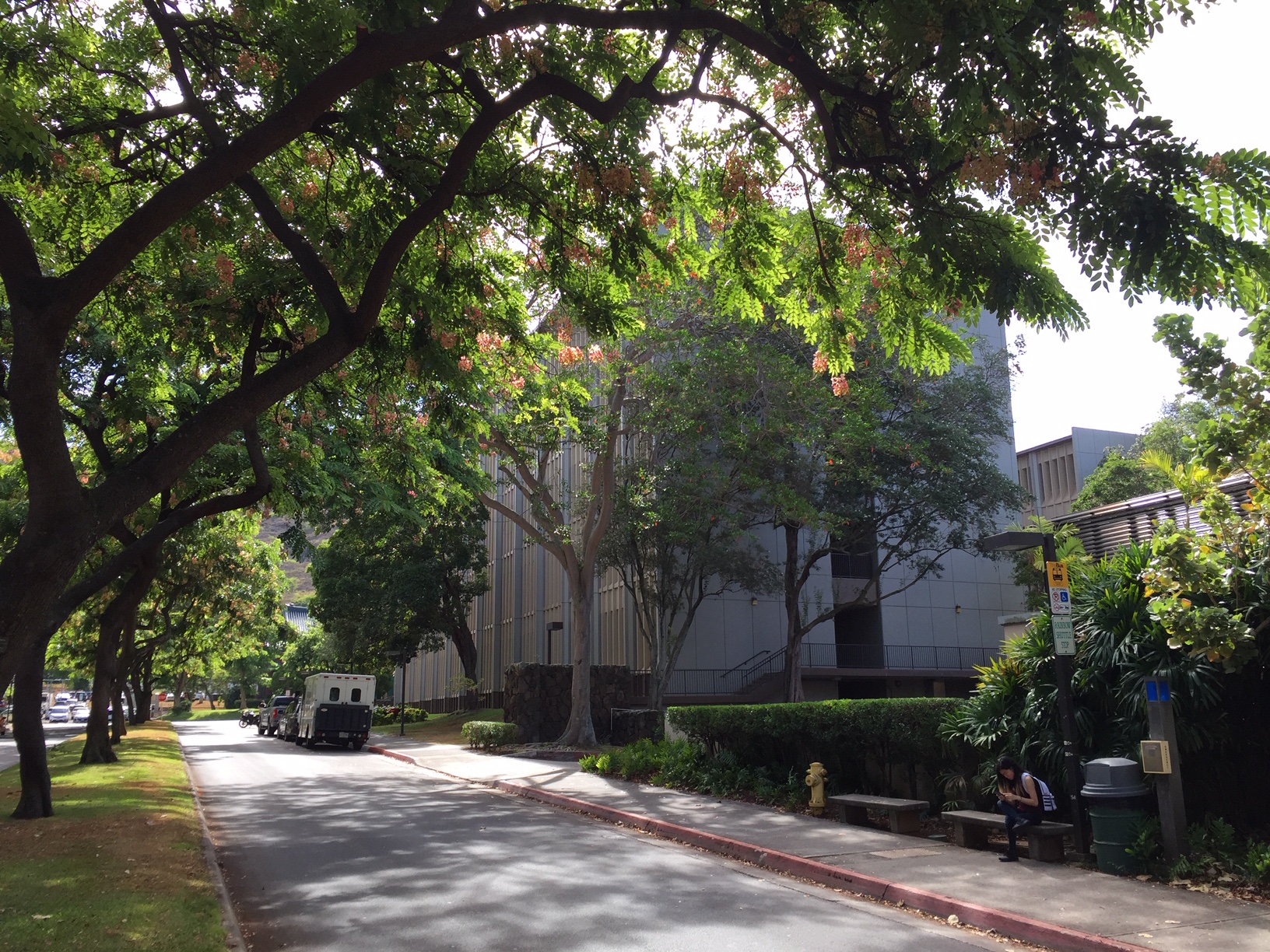(Part of the text that follows was contributed by Prof. Shana Brown, History)
The University of Hawai‘i dates to 1907, when the Hawai‘i Territorial Legislature established the College of Agriculture and Mechanic Arts in Honolulu. It was renamed the College of Hawai‘i in 1912.
The elevation of the College to a University was largely due to the activism of a Chinese-American cashier at the Bank of Hawai‘i—Honolulu-born William Kwai Fong Yap (葉桂芳1873–1935).
In 1919, Yap wrote a letter to the editor of the Honolulu Star-Bulletin, noting that “need (for a university had) been felt for many years by a great number of poor but ambitious young men and women who have been forced to go to the mainland to get what they desire in their special line of education. Any opposition to expenditures for educational purposes is not worth of consideration. Education cannot be measured in terms of dollars.”
In 1920 Yap garnered sufficient signatures to successfully petition the Hawai‘i Territorial Legislature to elevate the College of Hawai‘i to university status. The university began to offer courses in what was then called “Oriental” i.e. East Asian studies, including Chinese, making UH the fifth U.S. institution to offer the language, after Yale (1877), Harvard (1879), the University of California at Berkeley (1896), and Columbia University (1901).

William Kwai Fong Yap in 1920
In 1921, the Board of Regents reported to the Legislature that “the finding of a suitable man for instruction in Chinese proved to be particularly difficult and it was not until December of 1920 that Dr. Tien Mu Wang was secured.” Prof. Tien Mu Wang (王天木, jinshi degree, Chinese imperial examinations; LL.B. Chuo University, Japan), taught Chinese history and language at U.H. [See p. 1, “The Department of History at the University of Hawaii”, here. ]

The next year, in August 1921, Wang Tianmu hosted a delegation of Chinese educators, including the Peking University President Cai Yuanpei 蔡元培, at a Honolulu conference on the subject of education in the Pacific. Then faculty at UH, Wang Tianmu was empowered as a member of the five-person delegation representing the Chinese government.

Above: Chinese delegation to a conference on Pacific education, held in Honolulu, 1921. Cai Yuanpei is seated, center; Wang Tianmu is on the far right. (http://blog.sina.com.cn/s/blog_5922c71e0102dv0m.html)

The Chinese delegation visit the pineapple fields, August, 1921 (http://bailushi.com.cn/toFindPicsListByKeyWord.html?keyword=%E7%8E%8B%E5%A4%A9%E6%9C%A8)
In September 1922, Wang Tianmu left Hawai’i, to be replaced by Lee Shaochang 李照昌 (1891-1977; Yale B.A. 1917; Columbia M.A. 1918) the following year. Over the next decade, under Lee’s leadership, the size of the Chinese studies program expanded considerably. Departments of Chinese and Japanese were created. By 1930, the UHM ranked third among U.S. colleges & universities in the number of Asia-related courses offered. In 1933, over a hundred students were studying Chinese literature; over sixty students took classes on Chinese history; and almost a hundred and fifty students were studying Chinese culture and Asian religion, in addition to Chinese language taught by a Mr. Xie Tianyu 谢天玉.
In 1935, the Departments of Chinese and Japanese merged into the Oriental Institute, and Li Shaochang was made the first director. It began to accept PhD students in Chinese history and literature.

In 1937, Hamilton Library hired its first Chinese collection librarian, Cheuk-woon Taam (Tan Zhuoyuan 譚卓垣 1900-1946), who greatly expanded the collection. In 1922 the university library had roughly 1,500 volumes in its China collection; under the efforts of Taam, the collection grew to over 41,000 volumes by 1943. As Taam wrote, “As a whole our Chinese library represents a small nucleus of a well picked collection for Sinological studies. We are fairly well equipped with books on Chinese history, literature, philosophy, and art.” (See Kuang-tien Yao, “Cheuk-woon Taam and the Chinese Collection at the University of Hawaii Library,” Journal of East Asian Libraries No. 156, February 2013)

Cheuk-woon Taam and his family.
http://blog.sciencenet.cn/blog-672397-642338.html
The start of the World War II in the Pacific in 1937 led many Chinese intellectuals to flee educational institutions in Japanese-occupied cities like Nanjing and Beijing. Dr. Yuan Ren Chao 趙元任 left the Academia Sinica in Nanjing and came to Honolulu in 1939. He offered intensive Chinese language courses for graduate and upper-division undergraduates, before leaving to join the faculty at the University of California, Berkeley.

Chao, Yuan Ren
http://wiki.china.org.cn/wiki/index.php/Zhao_Yuanren
Also during the wartime period came Dr. Wing-tsit Chan 陳榮捷 (philosophy), who later became famous for his English-language works on traditional Chinese philosophy. Chan taught in the Department of Philosophy from 1937–42, and helped establish the East-West Philosopher’s Conference [see pp. 326–28, China Review International Volume 2 Number 3, Fall 1995, for an excerpt from an oral history archived at Columbia university, about his five years at the U of Hawai‘i].

http://lingnanfoundation.org/about-professor-wing-tsit-chan/

Bruce Lee (李小龙, 1940-1973), reading Wing-tsit Chan
Other faculty of the wartime era included Chen Shouyi (陳受頤, 1899-1978; BA Lingnan University, 1920; PhD University of Chicago, 1929) who was a specialist in comparative cultural studies. Chen had previously served as chair of the History Department at Beijing University from 1931-1937, and stayed at UH until 1941, when he moved to California.

Chen Shouyi teaching a student at Pomona College, 1946.
In the 1950’s, the US government began to significantly prioritize funding for Asian language instruction, including Chinese. UH faculty were active in organizations that promoted Chinese-language instruction, like the American Association of Chinese Language Instructors, founded in 1962. This association was co-founded by the remarkable John Young (Yang Jiaoyong 杨觉勇, 1920 – 2013). Born in Tianjin and educated in Japan, graduating from Tokyo Imperial University in 1942, Young daringly traveled across occupied China to serve in Chiang Kai-shek’s wartime government in Chongqing. At one point he served as a translator for Mao Zedong in conversation with Japanese anti-war activist Wataru Kaji (鹿地 亘, 1903–1982). After the war he did important work for the Chinese government in collecting evidence of Japanese war crimes in preparation for the Tokyo trials. Young later helped found the American Association of Chinese Language Instructors (now the Chinese Language Teachers Association, USA) and served as its director while at UH from 1964-1974.

John Young
In 1959, Madame Soong Mei-ling (Madame Chiang Kai-shek, first lady of the Republic of China) visited the Mānoa campus to address graduates and guests at Commencment. She is seen here with Regents Chair Philip Spalding.

Another figure of international reknown is Prof. Li Fang-Kuei 李方桂 who taught Chinese linguistics from 1969 until he retired in 1974, specializing in historical linguistics, particularly the phonetics of Tai languages.

https://en.wikipedia.org/wiki/Li_Fang-Kuei
Prof. John DeFrancis was educated at Yale and Columbia Universities, and came to UH after having been blacklisted for a decade by McCarthyism. He chaired the Department of East Asian Languages and Literatures until his retirement, then, as professor emeritus, wrote three books (The Chinese Language: Fact & Fantasy, Visible Speech: The Diverse Oneness of Writing Systems, In the Footsteps of Genghis Khan), and worked with the Center for Chinese Studies to edit and publish three titles in the ABC Dictionary series.

https://www.nytimes.com/2009/01/15/us/15defrancis.html
Prof. Elizabeth Wichmann-Walczak trained under Madam Shen Xiaomei, a disciple of the famed Mei Lanfang, and built an internationally known program in Chinese theatre at UH during her tenure from 1981 to 2018. She translated and staged traditional jingju or kunqu every four years; three of those performances toured China.

Elizabeth Wichmann-Walczak (left) and Shen Xiaomei http://archives.starbulletin.com/2006/02/12/features/story02.html
The University’s extensive China-focused faculty resources were organized first as the Council for Chinese Studies in 1977, and then as the Center for Chinese Studies (CCS) in 1987. The prominent artist Yu Ho (Betty) Ecke was the first Chair of the Council, from 1977 to 1983.

Tseng Yu-ho, Chair of the Council for Chinese Studies, in 1959
http://blog.honoluluacademy.org/remembering-the-multitalented-dr-tseng-yuho/

Daniel Kwok, in 2013. http://planetearthandhumanity.blogspot.com/2013/11/im-transitioning-from-31-years-in-my.html
Prof. Kwok was the first director of the Center for Chinese Studies, whose term ran from 1987 to 1991.

Roger Ames, director of the Center for Chinese Studies from 1991–2000. http://en.yiduobufen.com/
 .
.

2018-2021

2021–
Ronald C. Brown of the Williamson School of Law was CCS director from 2000-6, Rosita Chang of the Shidler College of Business from 2006-9, and Frederick Lau of Ethnomusicology from 2009–18. CCS associate director Cynthia Ning was interim director in the Spring of 2018, and David Yang of the Shidler College of Business took over in Fall, 2018. He was director through the pandemic of 2020, and ended his term in Summer, 2021. Ming-Bao Yue of the Department of East Asian Languages & Literature assumed the directorship in Fall, 2021.
Perhaps CCS’s most famous alumnus is Hao Ping 郝平, who came to us as the second visiting scholar on the university’s exchange program with Peking University. Then deputy director of Beida’s Office of Student Services, he arrived in Honolulu in 1991, and remained for a total of 4.5 years, completing a Master’s in History during this time. He returned to Beida to become head of the Office of International Relations, and was later promoted to Vice President. He picked up a PhD along the way—his dissertation was on “Sun Yat-sen and America”—which was translated into English by CCS and published by the press of the Beijing Foreign Studies University (BFSU). His next career move was to the presidency of BFSU. From there, Hao Ping was promoted to the Ministry of Education, where he served as Vice Minister for seven years. This period included a term as Chair of the 37th session of UNESCO (2011-16). At the end of 2016, he first became Party Secretary of his alma mater, Peking University, and in 2018, President.
Hao Ping at the United Nations
In 1978, UHM was awarded the first National Resource Center for East Asian Studies (NRCEA) by the U.S. Department of Education. With two brief hiatuses, UHM been funded by the USDOE continuously since then.
The National Foreign Language Resource Center at the University of Hawaii was first established in 1990, and supports teaching and learning foreign languages, including Chinese.
In 2014, the National Flagship Program for Chinese was established to help bring student proficiency in Chinese to the “superior” (professional) level.
The Center’s mission is to further strengthen Chinese Studies within the University system by supporting research, student learning, and community outreach. For a 10-minute oral introduction in Chinese to the website of the Mānoa Institutional Research Office, that compiles data about the University, go here (for mainland Chinese Mandarin) or here (for Taiwan Mandarin).
Sources:
D.W.Y. Kwok, “Our History: The Department of History at the University of Hawaiʻi” (2006), http://manoa.hawaii.edu/history/about/our-history/#_edn1
Kuang-tien Yao, “Cheuk-woon Taam and the Chinese Collection at the University of Hawaii Library,” Journal of East Asian Libraries, No. 156 (Feb 2013) (https://scholarspace.manoa.hawaii.edu/handle/10125/32914)
Yao Daozhong 姚道中, “The University of Hawai’i and Chinese Language Instruction in the United States 夏威夷大学和美国的中文教学. TCSOL Studies 53:1 (2014) (DOI:10.16131/j.cnki.cn44-1669/g4.2014.01.002)

